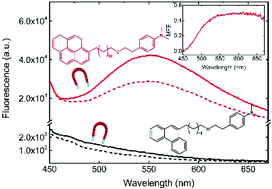Quantitative imaging of magnetic field distribution using a pyrene-based magnetosensing exciplex fluorophore†
Abstract
Quantitative imaging of magnetic field distribution was carried out using a pyrene-based magnetosensing exciplex fluorophore, pyrene-(CH2)12-O-(CH2)2-N,N-dimethylaniline (Py-12-O-2-DMA), on a conventional fluorescence microscope with an off-the-shelf LED lamp. No continuous sample supply was required for the process. The solvent system (anisole : DMF, 50 : 50 (v/v)) was carefully selected for monitoring the extent of modulation caused by the external magnetic field. The emission from Py-12-O-2-DMA increased by ca. 1.5 times under an external magnetic field of 50 mT. The pyrene-based reporter was ca. 24.7 times brighter than a previously reported phenanthrene-based complex when excited by using the widely available 355 nm excitation. Moreover, the maximum wavelength up to which Py-12-O-2-DMA could be excited (up to 380 nm) was longer than the wavelength up to which Phen-12-O-2-DMA could be excited. The combined advantages allowed the capture of magnetic field images with a high S/N ratio under milder conditions such as low illumination power, reduced sample concentration, and simpler optical setup. The system was also found to be feasible for 3D magnetic field distribution imaging by two-photon fluorescence microscopy.



 Please wait while we load your content...
Please wait while we load your content...